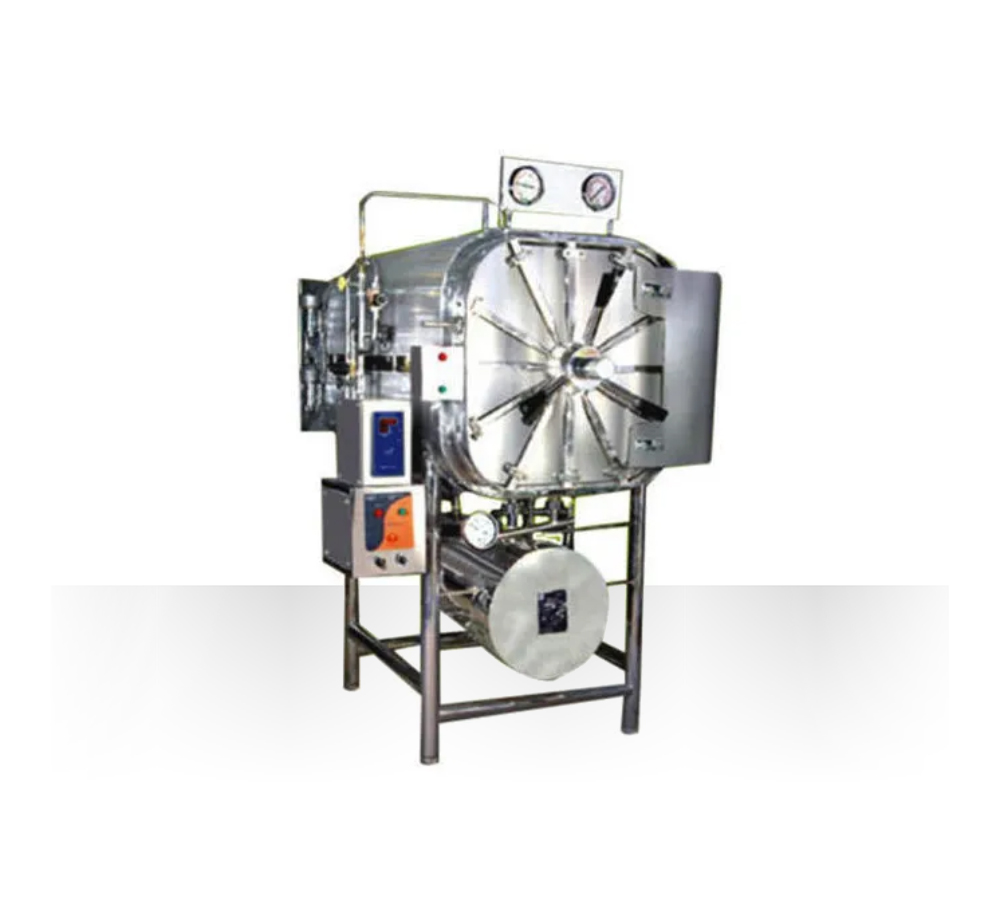Manufacturer of Industrial Sterilizer Machine, Industrial Autoclave Sterilizer India
Sterilization in autoclave for pharmaceutical industry MAP pharmaceutical autoclaves are designed and manufactured in a state of the art facility in compliance with GMP regulations to meet the technical challenges of pharma and biotech industries, Industrial Autoclave sterilizer. MAP autoclaves provide precise control and reliable sterile processing and pasteurization. MAP provides high quality & safe autoclaves made from reliable long lasting components, and designed to conform to end-user requirements (URS) for production and quality assurance, processes.
Autoclave sterilization processes, the steam is the agent most commonly used, although there are other methods such as waterfall, spray of water and mixture of vapor-air which can also be used. The latent heat that is released to condense the steam in the elements to be sterilized, makes this process very efficient. The temperature ranges that attained during sterilization processes vary between 115 and134C.

The variety of products which are subject to sterilization processes is very wide, although it can highlight the following:
Industrial Autoclave Manufacturers in India
We are the World’s Leading Manufacturer of Composite Bonding Industrial Autoclaves in India. Efficient composite bonding equipment and sterilizers for the composites industries. We design and manufacture customized industrial autoclave machines as per client requirements.
Map Industries is one of the best industrial autoclave manufacturers in India. We offer a wide range of industrial autoclaves for various industries with the best quality such as mild steel horizontal industrial autoclave, mild steel cylindrical horizontal autoclave, double wall horizontal autoclave, and high pressure bio-medical cylindrical type horizontal autoclave.
- Bags / Bag IV
- Bottles
- Road
- Pouches
- Syringes
- Medical instrument
Objective
One of the most common applications of sterilization by autoclave, are those carried out on liquids and medical equipment in various containers, such as bottles, vials, ampoules or bags.
In most cases, it is necessary to monitor the temperature of the product during sterilization, whether in production lots, development cycles or validation. For this reason, MAP offers a wide range of accessories and attachments. With them you get a greater repeatability, makes re-validation much easier and more reliable.
Guidelines
The requirements for the processes of testing and validation of autoclaves depend on the type of use and the country. Some of the standards applied in such processes are: CE, EN 285, EN ISO 13485 and PDA. Technical Report No. 1 Validation of Moist Heat Sterilization Processes.
Those rules specified inter alia the 11-point temperature need, when you make a study of distribution of heat in an autoclave of between 1.5 and 2.5 m3. Distribution recommended for all these points is to allocate a sensor in each of the eight corners of the autoclave, one in the Center, one next to the drainage and a last with own autoclave temperature sensor.
Process Equipment
An autoclave applies both heat and pressure to the workload placed inside of it. Typically, there are two classes of autoclave. Those pressurized with steam process workloads which can withstand exposure to water, while circulating heated gas provides greater flexibility and control of the heating atmosphere.
The large autoclaves can be used to sterilize large volumes of parenting, which are packaged in pouches or bags, while bottles or blisters so often in smaller autoclaves.
Industrial autoclaves are pressure vessels used to process parts and materials which require exposure to elevated pressure and temperature. The manufacture of high-performance components from advanced composites often requires autoclave processing.
Methodology
CUSTOM DESIGN FOR LIMITED SPACE
MAP’s strong engineering capability allows for highly customized autoclave design. Facilities with space layout limitations will benefit from custom narrow design autoclaves which provide high capacity in a limited space. Narrow design autoclaves allow for more autoclaves in a given space to ensure continued sterile processing in case of autoclave downtime.
UNIFORM HEAT DISTRIBUTION
Fully jacketed chambers ensure uniform heat distribution to ensure consistent sterilization conditions for all loads in chamber. A chamber that is not fully jacketed may have cool spots which can cause improper sterilization.
PERFECTLY OPTIMIZED CYCLES
With years of research and customer feedback we have fine-tuned our formula for perfectly optimized cycles with the precise combination of pulses, timing, temperature control, speed and drying.
STAINLESS STEEL PIPING
Stainless steel piping and connectors are used to avoid corrosion which is necessary to safeguard the integrity of the autoclave and prevent contamination of the sterilized loads (either as chemical or particulate contamination).
SAFETY
Safety for personnel, autoclave and load are priority in the design, construction and operation of any MAP autoclave. MAP is committed to the highest industry safety standards and directives to ensure safety not only for your employees operating the autoclaves but also for your sterile processing facility and the loads being sterilized. MAP autoclaves are provided with redundant independent monitoring systems and audio-visual alarms to notify operators of any issue that requires attention. An emergency stop button on the loading side of the autoclave may be used to safely stop the autoclave cycle.
DOOR SAFETY
The autoclave doors are designed with a number of independent mechanical and digital safety features. This guarantees that if a problem should occur, an autoclave failure will be prevented.
- A safety device prevents the operator from opening the door when chamber is pressurized
- Steam is not allowed into the chamber when the door is open
- A cycle cannot start if the door is open or not properly locked
- The door cannot unlock until chamber pressure reaches room pressure
- Sliding Door Safety – The sliding door progress will automatically stop if an obstruction is detected
- Double Door Safety – interlocks prevent both doors from being
GENERAL SAFETY FEATURES
- Double Independent Monitoring: The combined digital and mechanical monitoring provides a cross reference and guarantees accurate results. The operator has two independent means to monitor temperature and pressure.
- Safety Valves: Both the chamber and the jacket are equipped with safety valves – if the pressure exceeds the allowed limit the safety valves will discharge
- Built-in Steam Generator Safety: A water level monitoring system maintains a constant water level and ensures safe operation of the heaters
- Emergency shut-off: Easily accessible emergency switches for immediate cycle shut-off
To document the validation in an appropriate manner, should be a diagram indicating the serial number of each of the sensors as well as the exact position in the interior of the autoclave. This process can lead to above very easily using the SCADA software.
Each work session, can incorporate a predefined schema, a picture or a Word document. Another factor that may be considered critical in the validation of autoclaves, is the calibration of temperature sensors. It is essential that the user can demonstrate that the sensors provide adequate accuracy when they are to be used. This implies a process of recalibration and post-calibration of sensors, in order to ensure that they continue, still within the pre-defined tolerances.
SCADA software greatly simplifies this procedure because it generates a complete report of validation that includes different requirements until now mentioned.
Chamber Dimensions
| (WxHxD) mm | Chamber Volume (Liter) |
| 610 x 910 x 915 | 510 |
| 610 x 910 x 1215 | 680 |
| 610 x 910 x 1515 | 840 |
| 610 x 910 x 1815 | 1010 |
| 660 x 1220 x 1620 | 1300 |

